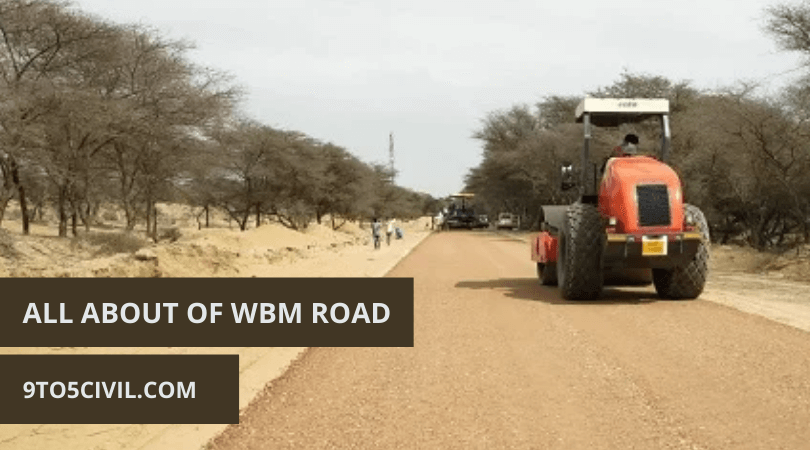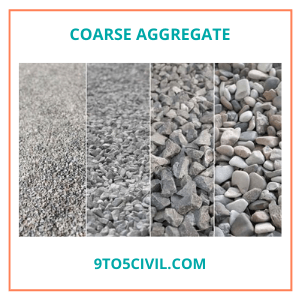
The WBM’s full meaning is water-bound macadam road. Appropriate points for road maintenance and road construction process are interpreted for road construction. Highway and road layout design, its implementation, and design of fixed dimensions are based on the traffic on the roads.
India has the largest road network in the world with 3.3 million kilometers This road network includes national highways, state highways, district roads, and village roads. Apart from this, recently constructed expressways and international highways are also included.
The method of different types of road construction is as follows:
- Soil Stabilization Roads
- Bituminous or Black Top Roads
- Water Bound Macadam Roads
- Cement Concrete Roads
- Earth Road and Gravel Roads
What Is WBM Road?
WBM Road was provided by Scottish engineer John Loudon Macadam. It has been used as a road construction method for the last 160 years.
In WBM road, wearing coarse is made by crushing aggregates with filler material mechanically by heavy compaction. It uses sand as a filler material. This wearing coarse is laid on the base course.
WBM road is the first choice for road construction in rural areas. WBM road is the most used road in rural areas. Because the road is paved when funds are available.
The design of the WBM road determines the thickness of each compacted layer corresponding to the traffic load. According to that design, the layer of WBM road is formed. The thickness of the WBM road is usually kept from 7.5 cm to 10 cm.
WBM can easily transfer a load of vehicles from the road surface. In addition, it is able to easily dispose of rainwater. Camber is provided in WBM Road. The road camber is given in WBM roads from 1 inch in 36 to 1 in 48.
Also Read : What Is Foundation Repair? | Signs of Foundation Problem | House Foundation Repair Methods
Materials Required For WBM Road Construction
The materials used in the WBM road construction mainly consist of the following materials.
- Coarse Aggregate
- Screenings (filler material)
- Binding Material
1. Coarse Aggregate
In the construction of the WBM road, hard, durable aggregates and broken stones are used as coarse aggregates. The coarse aggregate used for each level in each construction step of the WBM road is selected by proper grading.
The aggregate used for the construction layers of WBM Road is selected according to the grading table given below,
| Grading Number | Size Range in (mm) | Sieve Size in (mm) | Percentage By Weight Passing the Sieve |
| 1 | 90 to 40 | 100 | 100 |
| 80 | 65-85 | ||
| 63 | 25-60 | ||
| 40 | 0-15 | ||
| 20 | 0-5 | ||
| 2 | 63 to 40 | 80 | 100 |
| 63 | 90-100 | ||
| 50 | 35-70 | ||
| 40 | 0-15 | ||
| 20 | 0-5 | ||
| 3 | 50 to 20 | 63 | 100 |
| 50 | 95-100 | ||
| 40 | 35-70 | ||
| 20 | 0-10 | ||
| 10 | 0-5 |
- The aggregate used for WBM road should have some of the following properties.
- The coarse aggregate for WBM road must have sufficient durability.
- The coarse aggregate should be hard. Which is able to resist loads.
- The amount of elongated and flaky particles as coarse aggregate for WBM road should be less.
- The gradation for WBM roads should have a range of sizes as shown in the gradation table.
2. Screening Materials
After compacting the coarse aggregate layer, additional spaces remain between the coarse aggregate. Filling material is used to fill these gaps. Which is called screening.
Aggregates smaller than coarse aggregates are used as screening material.
The screening material required for the construction of WBM Road is taken as per the standardized table given below.
| Grading Classification | Size of Screenings in (mm) | Sieve Size in (mm) | Percentage by weight passing the sieve |
| A | 12.5 | 12.5 | 100 |
| 10 | 90-100 | ||
| 4.75 | 30-Oct | ||
| 0.15 | 0-8 | ||
| B | 10 | 10 | 100 |
| 4.75 | 85-100 | ||
| 0.15 | 10-30 |
According to the Indian Road Congress, WBM has recommended the use of non-plastic materials as road construction. Which should comply with certain conditions as follows,
- The liquid limit of this type of material should be less than 20%.
- The plasticity index of this material should also be less than 6%.
Also Read : What are Traps? | Specification of Plumbing Trap | 14 Types of Traps in Plumbing
3. Binding Material
The use of binding material in the construction of WBM Road should be checked and authorized by an authorized engineer working on site. The plasticity of the binding material should be tested.
Binding material is not required if material like murram or gravel is used as screening material for the construction of WBM road. Because this content has a crashable property.
Also Read : What Is Gable Roof? | Design of Gable Roof | Types of Gable Roofs | Advantage & Disadvantage of Gable Roof
Construction Procedure of WBM Road
1. Preparation of foundation for WBM Subgrade or base courses :
Surfaces are prepared for the required camber in the subgrade or base course. And depressions and pot-holes on existing road surfaces are filled.
Dust and other loose materials from the existing road surface are cleaned for a subgrade layer.
Excess debris is removed by shaping the existing road surface to the required grade and camber
2. Provision of the Lateral Confinement
To provide the lateral confinement required for coarse aggregate for WBM Road, a shoulder equal to the compacted WBM layer is constructed in advance.
Good quality materials or moorings should be used in the construction of shoulders. Shoulders are prepared by proper compaction. So that the material of the road structure between wbm road can be maintained.
3. Spreading of the Coarse Aggregates
The mass of coarse aggregates for the surface of the subgrade is stacked at the required length of the road at certain intervals.
Coarse aggregates are spread evenly on a subgrade base using machinery like dozers.
The total number of layers and the overall thickness are kept according to the design for WBM road. The aggregate is spread in such a way in the thickness of each layer. So that its thickness after compaction is 7.5 cm.
Generally, a thickness of 75mm for a single layer thickness is reserved for normal roads.
Typically for rural roads, the thickness of the compacted layer of coarse aggregates in a single layer is kept at 75 mm. When for important roads, the thickness of the compact of coarse aggregates is kept at 150 mm. Which is provided in two levels.
4. Rolling Process
The rolling process for WBM Road is started from the edge of the road. Then compaction is done by rolling in the center for the straight section of the road. For the superelevation curve of WBM road, compaction is done by the rolling process from the lower end of the rolling to the upper edge.
For WBM road construction, vibration rollers or power rollers weighing 6 to 11 tons are used for compaction by rolling.
Skilled operators are used to operating the roller for compaction of WBM Road.
5. Application of the Screening
After the process of compaction is completed by rolling the coarse aggregate, the screening material is filled in the space in the coarse aggregate. Screening is applied in three or more layers in the constriction of the WBM road. It provides a uniform surface for the road.
For WBM road construction each layer should be compacted by dry rolling in sufficient quantity. If for some reason proper compaction is not done by rolling then the wearing process of the rod will start soon.
6. Sprinkling and Grouting
Plenty of water is sprinkled on the surface of the screening road. The filling material will swift and roll into the road surface by vibration using a roller.
The weight screening material in the voids in the coarse aagregate is then cleaned using a hand broom. The re-screening material is then applied. This process is repeated until the mass of aggregate remains void between each other.
This process will increase the strength of the coarse aggregate layer. Therefore the load-bearing capacity of the road will be increased.
7. Application of the Binding Material
The binding material is applied to the surface of the compacted layer of coarse aggregate. It is applied on compacted coarse surface in two or three layers at slow rate and uniform layer.
After applying the bonding material layer as a layer of WBM, each surface is sprayed with water. This is done using a hand broom to fill the void.
Rollers of 6 to 10-ton capacity are used for compaction by rolling for wbm road construction. During the rolling process, the sprinkler system is turned on in the wheel of the roller to prevent the binding material from sticking to the roller wheels.
8. Setting and Drying
The surface of the WBM road is sprayed and rolling for 24 hours. If depression appears on the road surface the next day, it is filled with screening or binding material.
9. Preparation of Shoulder
The shoulders for the road are filled with earth. The shoulders of the road are prepared by rolling and spreading water in proper proportions.
10. Opening to Traffic
After the surface of WBM Road has dried, it is opened for traffic.
Advantages & Disadvantages of WBM Road
Advantages of WBM Road
- The construction cost of WBM road is less than other types of road.
- The construction of WBM roads requires less skilled manpower.
- Materials for building WBM are easily available locally.
- The carrying capacity of the WBM road can carry a traffic load of about 900 tons of lanes per day.
Disadvantages of WBM Roads
- WBM roads are less durable than other roads.
- WBM Road maintenance can cause inconvenience and danger to traffic if not carried out periodically.
- WBM Road enters the rainwater. Which increases the cost of road maintenance.
- The maintenance cost of WBM Road is high. Because it has to be maintained periodically.
Maintenance of the Water Bound Macadam Roads
- Regular maintenance is required as water bound Macadam roads are not more sustainable.
- The surface of WBM roads is prone to potholes during the rainy season. The void on its surface should be filled with the appropriate quality binding material.
- Corrugations Material should be removed from the road surface and filled with the suitable quality binding material.
- Loose aggregate in WBM paths should be properly compacted on the surface.
Like this post? Share it with your friends!
Suggested Read –
- What Is Pavement Marking? (Road Marking) | Importance of Pavement Marking | Functions of Road Markings | Types of Pavement Marking And Their Meanings | Advantages & Disadvantages of Pavement Marking
- Difference Between Load Bearing Structure and Frame Structure | What Is Load Bearing Structure? | What Is Frame Structure?
- What Is Pile Foundation? | Uses of Pile Foundations | Types of Pile Foundations |
- What Is Vacuum Concrete? | The Necessity of Vacuum Concrete | Properties of Vacuum Concrete | Application of Vacuum Concrete | Advantages & Disadvantages of Vacuum Concrete | Process of Vacuum Concrete
- What Is MDF? | MDF Board Uses | MDF Board Properties | Application of MDF Board |
 Skip to content
Skip to content



